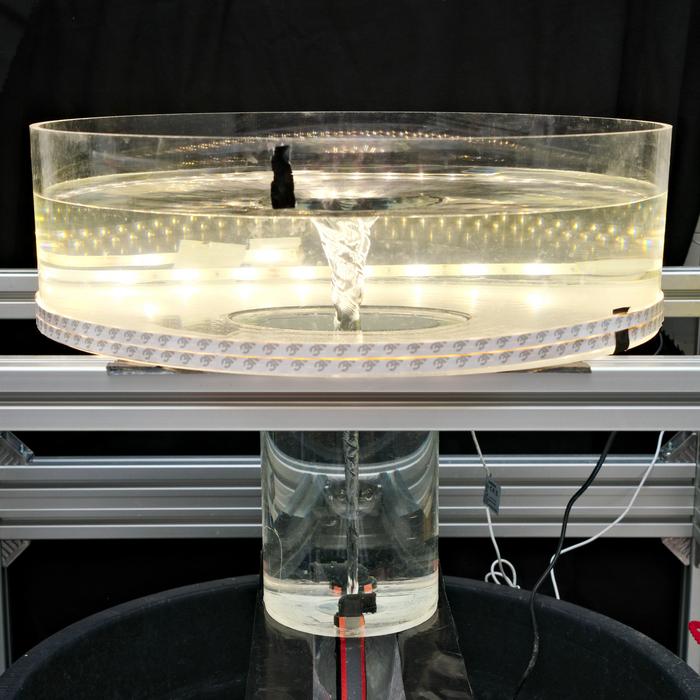Sometimes the easiest way to understand the physics of a phenomenon is to make a physical model of it. But how do you make a model of a system as large as, say, a protoplanetary disc? One technique, suggested in a recent paper in the Monthly Notices of the Royal Astronomical Society Letters by researchers at the Max Planck Institute for Astrophysics and the University of Greifswald, would be familiar to any grade schooler who took a science class – spin water around in a circle really fast.
The system the researchers came up with was obviously more complicated than the bottle vortex experiment performed by many children, but the underlying idea is the same. In a protoplanetary disc, the gas and dust that end up forming planets moves around the newly formed star in a gravitational dance that eventually results in that gas and dust clumping together to form proto-planets, the seeds of what would eventually become planets. A water vortex has many of the same properties, with the vortex itself serving as the central gravitational point of the system.
Typically, these systems have been simulated, rather than modeled, in the past. However, modeling such complex interactions as individual dust particles coalescing into much larger collections is not easy from a computational standpoint. Also, simulations must be compared to experimental data, which is not always easy to come by given the difficulty in being granted observational time on a powerful enough telescope.
Fraser and Pamela discuss accretion discs like the ones modeled by the vortex.
Water vortices, on the other hand, can be created at will, and can last as long as the creators want. This also isn’t the first time such a system has been used to mimic planetary formation. However, previous iterations had relatively limited ring-shaped zones that also limited their usefulness. In addition, the new system more closely mimics the observations of known planet-creating discs.
Doing so proved relatively simple from an engineering standpoint. Two transparent cylinders with differing sizes are stacked vertically, with the larger one on top. There’s a drain tube at the bottom of the smaller cylinder, while two nozzles pump water horizontally into the bottom cylinder using a standard aquarium pump. With enough force, that water begins to spill over into the larger cylinder on top, which is where the true magic happens.
To test their device, the researchers threw a bunch of beads into the vortex and tracked their progress to see how well it matched up with observational data. After repeatedly capturing the position of the beads with a high speed camera the researchers ran an algorithm to determine each bead’s path. Johannes Kepler famously developed the laws of planetary motion in the early 1600s, and one metric to measure these models by is how well they adhere to those laws.
Orbital mechanics is a complicated process, as Fraser discusses with Dr. Renu Malhotra
In the new water vortex’s case, it does pretty well on #2 and #3, which are that a planet (or in this case a bead) would cover equal areas in equal time, and a specific mathematical relationship between an orbital period and its size. The beads in the experiments match those laws well. However, as with other vortex-based experiments, it had trouble adhering to Kepler’s first law of planetary motion – that they follow elliptical paths. Beads in smaller water vortices follow paths that look more like spirals, but that can also be fixed by scaling up the system, allowing for more stability in the flow pattern and therefore elliptical paths themselves to form.
That is the plan for the next iteration of the model – the researchers plan to scale it up to a point where it can have elliptical paths comfortably inside of the swirling vortex. But that remains for a future paper – for now, they will continue to test the benchtop version, and by extension get to relive one of the most popular kid’s science experiments for a long time yet to come.
Learn More:
Max Planck Institute for Astronomy – Water tornado in the laboratory: A simple experiment simulates planet formation
S. Knauer et al – A tornado-based laboratory model for Keplerian flows
UT – Scientists Gain a New Understanding of How Stars and Planets Form
UT – Do The Gaps in Protoplanetary Disks Really Indicate Newly Forming Planets?
